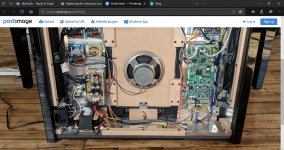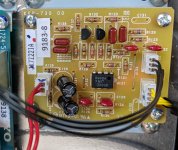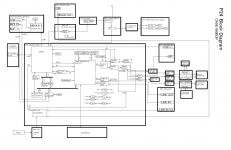Hi everyone,
I am a serious (but amateur) classical pianist that no longer has the ability to use an acoustic grand piano due to noise constraints, so I purchased the Kawai Novus NV10 digital piano. This is a hybrid instrument that uses a real acoustic grand action mated to optical sensors and a digital piano cabinet. So, you get all of the feel of a real acoustic without the noise.
There is just one problem - the built in audio is atrocious given the cost of the instrument. The only way I can get good sound out of it is to hook it up to my computer and use it as a midi controller with Pianoteq software and my Sennheiser HD650 headphones. But the speakers are horrendous, so I figured I would open it up and take a look.
Frankly, this sound system seems like a complete afterthought to me from both an architectural and quality standpoint. The woofers feel cheap, there is no real crossover network, there is point-to-point "fix it" wiring on the mainboard, and the system is generally underpowered.
Given the poor design and components of the system, I am wondering if I can simply take the audio output off of the mainboard, run it through something like a miniDSP and then directly to my own amplifiers and replacement drivers?
I spent some time today and drew up a schematic of the way the sound system currently works.
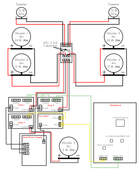
Looking at it, I have several questions:
1. It seems that the mainboard has separate audio outputs for L/R channel and bass. I assume this means a digital crossover for the bass woofer? This is one issue that I may have to figure out that could impact driver selection.
2. I do not understand the pinouts or number of wires used on this system, it does not seem logical. For example, there are five wires coming off of the mainboard for the L/R channel output, which corresponds with five pins in the input of the Amp. But when the output of Amp 2 is daisy chained with the input of Amp 1, there are only three wires. Why?
3. Why does the bass signal need to be pre-amped, but the L/R channels do not?
4. Is there a way I can find out whether or not the signal coming off the mainboard is flat or processed to hell?
Here are some more pictures of the system. I would really appreciate any help!
View of the action with the cover off
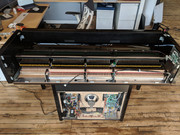
Amplifier Section
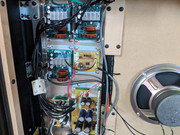
Bass amp and Preamp
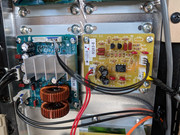
"Crossover"
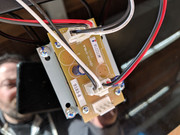
How the drivers are mounted to the lid of the piano
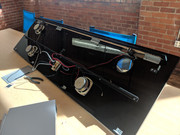
View with back cover removed
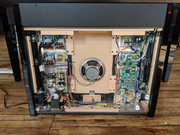
Close up of L/R channel amps

Mainboard
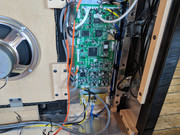
Mainboard 2
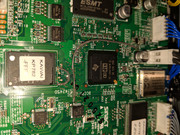
Mainboard output section
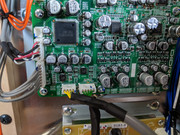
I am a serious (but amateur) classical pianist that no longer has the ability to use an acoustic grand piano due to noise constraints, so I purchased the Kawai Novus NV10 digital piano. This is a hybrid instrument that uses a real acoustic grand action mated to optical sensors and a digital piano cabinet. So, you get all of the feel of a real acoustic without the noise.
There is just one problem - the built in audio is atrocious given the cost of the instrument. The only way I can get good sound out of it is to hook it up to my computer and use it as a midi controller with Pianoteq software and my Sennheiser HD650 headphones. But the speakers are horrendous, so I figured I would open it up and take a look.
Frankly, this sound system seems like a complete afterthought to me from both an architectural and quality standpoint. The woofers feel cheap, there is no real crossover network, there is point-to-point "fix it" wiring on the mainboard, and the system is generally underpowered.
Given the poor design and components of the system, I am wondering if I can simply take the audio output off of the mainboard, run it through something like a miniDSP and then directly to my own amplifiers and replacement drivers?
I spent some time today and drew up a schematic of the way the sound system currently works.

Looking at it, I have several questions:
1. It seems that the mainboard has separate audio outputs for L/R channel and bass. I assume this means a digital crossover for the bass woofer? This is one issue that I may have to figure out that could impact driver selection.
2. I do not understand the pinouts or number of wires used on this system, it does not seem logical. For example, there are five wires coming off of the mainboard for the L/R channel output, which corresponds with five pins in the input of the Amp. But when the output of Amp 2 is daisy chained with the input of Amp 1, there are only three wires. Why?
3. Why does the bass signal need to be pre-amped, but the L/R channels do not?
4. Is there a way I can find out whether or not the signal coming off the mainboard is flat or processed to hell?
Here are some more pictures of the system. I would really appreciate any help!
View of the action with the cover off

Amplifier Section

Bass amp and Preamp

"Crossover"

How the drivers are mounted to the lid of the piano

View with back cover removed

Close up of L/R channel amps

Mainboard

Mainboard 2

Mainboard output section

Last edited:
Additionally, I just verified by unplugging the amps and then trying them just one at a time that each channel definitely has it's own amp.
With just the 8in woofer plugged in, I can hear even the top note on the keyboard coming out of it. So it appears that this may be a full-range signal passed through to the woofer.
With just the left channel amp plugged in, the entire left channel plays (tweeter and two woofers). I can push the 4in drivers to quite extreme xmax here; I am wondering if this is also a full range signal.
Would they really go through the hassle of having two separate outputs on the mainboard just to send two duplicate full-range signals? Seems like a waste?
Thanks
With just the 8in woofer plugged in, I can hear even the top note on the keyboard coming out of it. So it appears that this may be a full-range signal passed through to the woofer.
With just the left channel amp plugged in, the entire left channel plays (tweeter and two woofers). I can push the 4in drivers to quite extreme xmax here; I am wondering if this is also a full range signal.
Would they really go through the hassle of having two separate outputs on the mainboard just to send two duplicate full-range signals? Seems like a waste?
Thanks
Without proper documentation and circuit diagrams it all becomes guesswork... even if educated guesswork 
The preamp board with the 4558 opamp looks to be more than just a gain block. The quantity and appearance of the passive parts suggests some kind of (probably) standard opamp type filter circuit. The transistors could be for muting to ensure silence when no keys are depressed.
The best way to gauge what the main board outputs are like could be to rig up an AC coupled feed to output to some external amplifier and see what the results sound like.
The preamp board with the 4558 opamp looks to be more than just a gain block. The quantity and appearance of the passive parts suggests some kind of (probably) standard opamp type filter circuit. The transistors could be for muting to ensure silence when no keys are depressed.
The best way to gauge what the main board outputs are like could be to rig up an AC coupled feed to output to some external amplifier and see what the results sound like.
Do can you think of any logical reasons they would use one 5 wire output and one 4 wire output instead of simply using two wires for stereo? I may start unplugging pins one at a time and see what impact it has.
One good thing about this piano is that it does have a line in, so I can play whatever test tones I wish through the speakers.
One good thing about this piano is that it does have a line in, so I can play whatever test tones I wish through the speakers.
Interesting thread! Can I ask why you don’t simply take the output from the line out (at least the specs claim there is one) and run that to your own amp/speakers?
But I wonder if it really sounds better than some of the aftermarket grand piano samples like ivory? It is hard to gauge from the marketing material but i am curious what your impression is?
But I wonder if it really sounds better than some of the aftermarket grand piano samples like ivory? It is hard to gauge from the marketing material but i am curious what your impression is?
Your images come out thumb-size; I can't see much.
The one review of this model I found said it could be somewhat louder than a real baby grand next to it.
For $12K the dealer should come to your house and make it right. If he can't/won't make you happy, Kawai should back-up their product. Yamaha would do that, and Kawai is playing in Yama's league.
Maybe something is wrong in your piano, your power, or your room. (I concede that you probably know the room very well.)
The one review of this model I found said it could be somewhat louder than a real baby grand next to it.
For $12K the dealer should come to your house and make it right. If he can't/won't make you happy, Kawai should back-up their product. Yamaha would do that, and Kawai is playing in Yama's league.
Maybe something is wrong in your piano, your power, or your room. (I concede that you probably know the room very well.)
I can't believe this doesn't have a headphone output: With silence feature when you have a plug in that socket.
Use that through a 1/8" stereo to dual 1/4 phone plugs or something to go to an external amp. Or if you are terribly interested in 28-54 hz, separate out a 3rd channel with a crossover for subwoofer amplifier .
I get very good sound out of my $699 ea new ( I bought them used.) SP2 speakers, on poles above and around my Hammond theatre organ. I play piano CD's all the time, it sounds very good. I use about 1/4 watt base level, (1.5 vpp 8 ohms) but for the peaks of hammer hit on ff passages I have 70 watts/ch. 200 w/ch would not be unrealistic on piano, with my 101 db 1w 1m speakers. The SP2 are +-3db 54 hz -14 khz. I don't have any hearing above 14 khz so I don't miss it. These speakers have a quoted distortion level at 1 w, look for that on any other product spec sheet. The CS800s sounds really good even though I use low wattage in my LR. Also it is available at the store.
My living room has plaster walls broken up by record racks bookcases the organ carpet and overstuffed couch, so I have no standing waves to mess up the sound. The sound bounces off the walls well enough that I don't need special monitors when I play. I use a digital effect box on the Hammond sometimes to simulate a huge rotary leslie speaker.
I have wood pianos to play in other rooms, but I live on a 1/3 acre lot in a separated house, so the neighbors don't complain if I play ff at 3 AM. This neighborhood isn't stylish, but it fits my music all the time lifestyle.
For other speakers than diyaudio posters think are worthy of hifi, see this thread: PA speakers for home HiFi use
Not everybody lives in the US south as I do. Nobody will demo Yamaha or JBL pro equipment, which are reputed to also sound good in the 15" woofer + 2" horn category. Don't waste time on 1" driver horn models, the midrange can be quite bumpy.
Use that through a 1/8" stereo to dual 1/4 phone plugs or something to go to an external amp. Or if you are terribly interested in 28-54 hz, separate out a 3rd channel with a crossover for subwoofer amplifier .
I get very good sound out of my $699 ea new ( I bought them used.) SP2 speakers, on poles above and around my Hammond theatre organ. I play piano CD's all the time, it sounds very good. I use about 1/4 watt base level, (1.5 vpp 8 ohms) but for the peaks of hammer hit on ff passages I have 70 watts/ch. 200 w/ch would not be unrealistic on piano, with my 101 db 1w 1m speakers. The SP2 are +-3db 54 hz -14 khz. I don't have any hearing above 14 khz so I don't miss it. These speakers have a quoted distortion level at 1 w, look for that on any other product spec sheet. The CS800s sounds really good even though I use low wattage in my LR. Also it is available at the store.
My living room has plaster walls broken up by record racks bookcases the organ carpet and overstuffed couch, so I have no standing waves to mess up the sound. The sound bounces off the walls well enough that I don't need special monitors when I play. I use a digital effect box on the Hammond sometimes to simulate a huge rotary leslie speaker.
I have wood pianos to play in other rooms, but I live on a 1/3 acre lot in a separated house, so the neighbors don't complain if I play ff at 3 AM. This neighborhood isn't stylish, but it fits my music all the time lifestyle.
For other speakers than diyaudio posters think are worthy of hifi, see this thread: PA speakers for home HiFi use
Not everybody lives in the US south as I do. Nobody will demo Yamaha or JBL pro equipment, which are reputed to also sound good in the 15" woofer + 2" horn category. Don't waste time on 1" driver horn models, the midrange can be quite bumpy.
Last edited:
Oh wow, I am an idiot! There is a pinout on the amps printed on the PCB! Pin 1: mute Pin 2: Hot Pin 3: Cold
Not at all
Your images come out thumb-size; I can't see much.
Try right clicking and opening the image in a new tab.
It is much better to attach images directly:
How to attach images to your posts.
Attachments
Thanks for all the responses everyone, I'm sorry the images did not work properly - I'll work on fixing that tonight.
The reason I don't want to do that is precisely because of my answer to you below
I am a long-time digital piano hater, so to speak. I studied piano at a Steinway school, so all I ever played on for several years were brand new Steinway D and Bs. No digital piano could ever get close in terms of action or sound.
Several years ago, I began experimenting with getting a better sound out of my previous Kawai digital piano. I got into VSTs and purchased Ivory, Garritan, etc. Some of them sounded quite good, but they weren't playable - I could clearly feel the steps in between each sample in terms of dynamics, and it just wasn't controllable to me for good music making.
Pianoteq changed everything. The built-in Steinway instrument is quite bad, but the Bluthner instrument with a lot of custom tweaking to resonances, wear level, and mic placement is a revelation. Combining that with EastWest Spaces convolution reverb, I am able to get recordings that are indistinguishable from a real acoustic grand in a concert hall. And as a mathematically modeled piano, there are no recorded samples - which means no "steps" other than Midi levels. It's an amazing piece of software, and combined with the real acoustic grand action on this new Kawai, I am able to replicate basically 99% of the experience of playing on a top-flight acoustic grand.
Now, the new piano does have a line-in - so I can actually take the Pianoteq signal from the computer and play it through the piano speakers when I am playing for others. But the built-in system is so bad that I need to upgrade it first.
It does have a headphone output, but it has an entire EQ section in hardware that is designed for headphones. I found the block diagram of the circuit in a service manual so now I have a bit more clarity.
That sounds like a really great setup! Unfortunately, since this is actually at my office I need to keep everything in one cabinet. I'm already pushing it to my employees that I threw a piano next to my desk, I'd rather not put a rack of audio gear and speakers next to it too.
So, this is the block diagram for the Kawai CA98, which is the same internal motherboard as my NV10. The main difference to keep in mind is that my instrument does not have the KSTR-003 Transducers, and has a different speaker arrangement. So everything "inside" the block of the motherboard is correct, while there are some differences outside the "block." - for example, on my piano the "mix" output does not go into an EQ, but rather right into the L/R channel amp.
But based on this, it does appear that one of the outputs has a LPF on it, and the other one sends out a full-range signal?
Interesting thread! Can I ask why you don’t simply take the output from the line out (at least the specs claim there is one) and run that to your own amp/speakers?
The reason I don't want to do that is precisely because of my answer to you below
But I wonder if it really sounds better than some of the aftermarket grand piano samples like ivory? It is hard to gauge from the marketing material but i am curious what your impression is?
I am a long-time digital piano hater, so to speak. I studied piano at a Steinway school, so all I ever played on for several years were brand new Steinway D and Bs. No digital piano could ever get close in terms of action or sound.
Several years ago, I began experimenting with getting a better sound out of my previous Kawai digital piano. I got into VSTs and purchased Ivory, Garritan, etc. Some of them sounded quite good, but they weren't playable - I could clearly feel the steps in between each sample in terms of dynamics, and it just wasn't controllable to me for good music making.
Pianoteq changed everything. The built-in Steinway instrument is quite bad, but the Bluthner instrument with a lot of custom tweaking to resonances, wear level, and mic placement is a revelation. Combining that with EastWest Spaces convolution reverb, I am able to get recordings that are indistinguishable from a real acoustic grand in a concert hall. And as a mathematically modeled piano, there are no recorded samples - which means no "steps" other than Midi levels. It's an amazing piece of software, and combined with the real acoustic grand action on this new Kawai, I am able to replicate basically 99% of the experience of playing on a top-flight acoustic grand.
Now, the new piano does have a line-in - so I can actually take the Pianoteq signal from the computer and play it through the piano speakers when I am playing for others. But the built-in system is so bad that I need to upgrade it first.
can't believe this doesn't have a headphone output: With silence feature when you have a plug in that socket.
Use that through a 1/8" stereo to dual 1/4 phone plugs or something to go to an external amp. Or if you are terribly interested in 28-54 hz, separate out a 3rd channel with a crossover for subwoofer amplifier .
It does have a headphone output, but it has an entire EQ section in hardware that is designed for headphones. I found the block diagram of the circuit in a service manual so now I have a bit more clarity.
I get very good sound out of my $699 ea new ( I bought them used.) SP2 speakers, on poles above and around my Hammond theatre organ. I play piano CD's all the time, it sounds very good. I use about 1/4 watt base level, (1.5 vpp 8 ohms) but for the peaks of hammer hit on ff passages I have 70 watts/ch. 200 w/ch would not be unrealistic on piano, with my 101 db 1w 1m speakers. The SP2 are +-3db 54 hz -14 khz. I don't have any hearing above 14 khz so I don't miss it. These speakers have a quoted distortion level at 1 w, look for that on any other product spec sheet. The CS800s sounds really good even though I use low wattage in my LR. Also it is available at the store.
That sounds like a really great setup! Unfortunately, since this is actually at my office I need to keep everything in one cabinet. I'm already pushing it to my employees that I threw a piano next to my desk, I'd rather not put a rack of audio gear and speakers next to it too.
So, this is the block diagram for the Kawai CA98, which is the same internal motherboard as my NV10. The main difference to keep in mind is that my instrument does not have the KSTR-003 Transducers, and has a different speaker arrangement. So everything "inside" the block of the motherboard is correct, while there are some differences outside the "block." - for example, on my piano the "mix" output does not go into an EQ, but rather right into the L/R channel amp.
But based on this, it does appear that one of the outputs has a LPF on it, and the other one sends out a full-range signal?
Attachments
Last edited:
I am wondering if I am overthinking this.
Since the goal is to have the DSP/amp/speakers contained in the enclosure, and have the ability to use either Pianoteq via line-in from my computer OR the built-in Kawai sounds, and I am willing to cut/solder/fabricate, why not just do this:
Install a second line-in jack on the cabinet routed directly to a minidsp (dedicated for Pianoteq). Then, route Kawai's line out to a second input on the minidsp. Then I can replace the amps and speakers and have total control. Is minidsp capable of automatic source selection? Or is that something I would have to have some sort of control scheme to switch between?
Thoughts?
Since the goal is to have the DSP/amp/speakers contained in the enclosure, and have the ability to use either Pianoteq via line-in from my computer OR the built-in Kawai sounds, and I am willing to cut/solder/fabricate, why not just do this:
Install a second line-in jack on the cabinet routed directly to a minidsp (dedicated for Pianoteq). Then, route Kawai's line out to a second input on the minidsp. Then I can replace the amps and speakers and have total control. Is minidsp capable of automatic source selection? Or is that something I would have to have some sort of control scheme to switch between?
Thoughts?
Last edited:
The electronics is the easy part.
Again, this thread PA speakers for home HiFi use
has some recommended "studio monitor" speakers which are designed to be listened to from two feet, between the pair. It won't be realistic on the zero octave, but what else is? You could put studio monitor speakers in the cabinet instead of the Kawai pair. If the kawai has high enough power to reproduce an ff hammer hit, then that may be all that is required. If not, then going off the usb output to a D/a board and your own 200w/ch amp may be required. Or on 80 db 1w 1m sensitivity monitors, even 400 w/ch. I'm all analog here on the hifi end of the room, so no knowledge of dsp etc. Don't know why you would want a digital processor, anyway. those are for frequency equalization curves & effects like reverb, flanger, etc. IMHO. The line out may be entirely adequate, but you may have to replace the line in from a microphone with a resistor to keep the internal processing from compensating for room effects.
It appears Kawai is using digital boards to make up for the inadequacies of their loudspeakers, with feedback from the inputs to cover up room effects like standing waves. I would ditch all that and buy decent speakers. But you have to treat the room to eliminate the standing waves, with soft furniture, drapes on walls, carpet, etc. Or go for the treatment in an actual studio,black sound absorbing foam on all the walls & ceiling.
Some extreme envy here. I'm not allowed to touch the Steinway grands around, they keep covers on them at the churches. I had access to a Baldwin 9' with a loose pin they were using as a plant stand, but the church gave it away. I don't have room here in my music room for a 9' grand , the 1940 Steinway 40 console will have to do. But the middle pedal is not like a grand, & I'm practicing Pictures @ an Exhibition.
Again, this thread PA speakers for home HiFi use
has some recommended "studio monitor" speakers which are designed to be listened to from two feet, between the pair. It won't be realistic on the zero octave, but what else is? You could put studio monitor speakers in the cabinet instead of the Kawai pair. If the kawai has high enough power to reproduce an ff hammer hit, then that may be all that is required. If not, then going off the usb output to a D/a board and your own 200w/ch amp may be required. Or on 80 db 1w 1m sensitivity monitors, even 400 w/ch. I'm all analog here on the hifi end of the room, so no knowledge of dsp etc. Don't know why you would want a digital processor, anyway. those are for frequency equalization curves & effects like reverb, flanger, etc. IMHO. The line out may be entirely adequate, but you may have to replace the line in from a microphone with a resistor to keep the internal processing from compensating for room effects.
It appears Kawai is using digital boards to make up for the inadequacies of their loudspeakers, with feedback from the inputs to cover up room effects like standing waves. I would ditch all that and buy decent speakers. But you have to treat the room to eliminate the standing waves, with soft furniture, drapes on walls, carpet, etc. Or go for the treatment in an actual studio,black sound absorbing foam on all the walls & ceiling.
Some extreme envy here. I'm not allowed to touch the Steinway grands around, they keep covers on them at the churches. I had access to a Baldwin 9' with a loose pin they were using as a plant stand, but the church gave it away. I don't have room here in my music room for a 9' grand , the 1940 Steinway 40 console will have to do. But the middle pedal is not like a grand, & I'm practicing Pictures @ an Exhibition.
Last edited:
- Home
- Live Sound
- Instruments and Amps
- Replacing the atrocious sound system on a $12,000 digital piano
